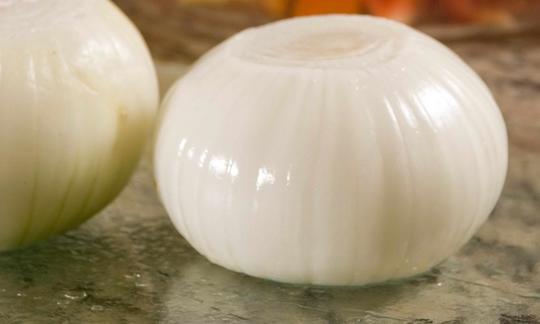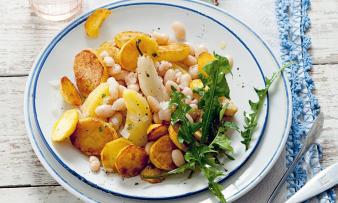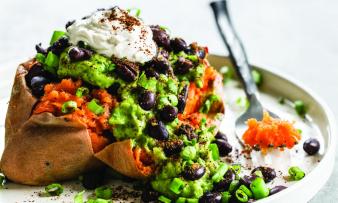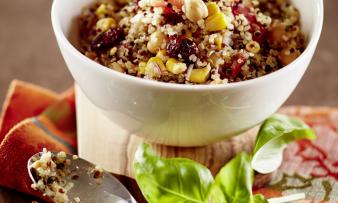Table of contents
Vegetable onions ( organic ) are not a botanical species, but a collective term within the onions ( Allium cepa ) . These slightly larger bulbs have a milder taste when raw, which is why they are also called sweet onions . The harder skin is easy to remove.
Use in the kitchen
Vegetable onions are ideal for cooking with their juicy flesh. The sweet onions are used for stewing, frying and stuffing. Due to their size, they are perfect for the grill or taste great stuffed and prepared in the oven (e.g. refined with rosemary, red bell peppers, soy granules ). The most popular are the light, copper-brown onions with white flesh, but there are also white and red-skinned vegetable onions.
Sweet onions taste great in casseroles, quiches, onion cakes, with other vegetables, but also in vegan soups, curries and stews. Spicy chutneys with tomatoes andapples can also be made by adding a vegetable onion.
Can you eat a vegetable onion raw? Due to its mild, sweet aroma, it is also great raw in salads, spreads, sauces and dips. Incidentally, shallots are also well suited to raw food recipes. They also have a sweeter and less spicy aroma than kitchen or cooking onions, but are significantly smaller.
Why do onions taste sweet after cooking? The heating process causes the glycosidic compounds to release sugar, making each onion taste a little sweeter.
To reduce the bad smell of your breath after eating raw onions, you can try the following: Chewing fresh green herbs such as mint, parsley or basil neutralizes the smell of onions with the chlorophyll they contain. You can also try lemon juice or water, apple cider vinegar (1 teaspoon in a glass of water) or green tea. A few cardamom seeds, chewed or brewed as a tea, can break down the sulfur compounds in a similar way to a freshapple and thus reduce the smell.
When cutting (light) onions, pink discoloration can occur, similar to garlic, which turns greenish. This discoloration is caused by reactions between amino acids and sulfur compounds and is harmless. 16
Vegan recipe for oven-baked vegetable onions
Ingredients (for 4 people): 4 large vegetable onions (organic), 50 ml rapeseed oil (or less), salt ,pepper, 1 bunch of fresh parsley .
Preparation: Peel the onions and cook them whole in salted water for 10 minutes. Drain well and cut in half. Place cut side up in a greased baking dish. Sprinkle with salt and pepper, drizzle a few drops of oil over them and bake in the oven at 180 °C for approx. 50 minutes. Sprinkle with the raw, freshly chopped parsley before serving.
Vegan recipes with vegetable onions can be found under the note: " Recipes that have the most of this ingredient ".
| Not only vegans or vegetarians should read this: Vegans often eat unhealthily. Avoidable nutritional mistakes. |
Purchasing - Storage
Vegetable onions ('sweet onions') are available in supermarkets such as Coop, Migros, Denner, Volg, Spar, Aldi, Lidl, Rewe, Edeka, Hofer, Billa etc. Organic supermarkets such as Denn's Biomarkt and Alnatura also have vegetable onions in their range. You can find more special varieties at weekly markets and in organic shops (see below). Buy regional organic produce for the sake of the environment.
It is better to check onions bought online carefully for damage or mold. A rotten vegetable onion can also infect the rest of the healthy ones and make them inedible. Because of the poorer shelf life, it is common practice to subject vegetable onions to heat treatment in order to extend their storage time. 20 Depending on the temperature, this can have a negative effect on the total flavanol content (see Effects on Health). 19
The availability of raw vegetable onions varies depending on the size of the store, catchment area, etc. Our recorded food prices for the DA-CH countries can be found above under the ingredient image - and by clicking on them you can see their development at various suppliers.
Storage tips
Vegetable onions are not as easy to store as normal onions. Vegetable onions contain a lot of water and will quickly start to rot if stored incorrectly. Store them in a dry, cool and dark place and leave a large space between the individual onions to avoid infection with diseases, rot or mold.
Peeled, cut onions lose their flavor quickly, which is why it's best to use them up immediately. If you still have too many, store them in the fridge in a cheese cover or another airtight container. Otherwise, the intense smell can transfer to other foods or packaging. Alternatively, leftover onions can be dried .
Ingredients - Nutritional values - Calories
The calorie content of a vegetable onion is 32 kcal/100g, slightly lower than that of a classic kitchen onion . It is practically fat-free (0.08 g/100g), consists of 91% water and contains mainly carbohydrates (7.6 g/100g), of which 5 g are sugar. The fiber content (0.90 g/100g) and protein content (0.80 g/100g) are low. 3
All species of the genus Allium do not contain starch as a reserve substance, but rather fructans. 11
The content of vitamins, macro-minerals and trace elements is similar to that of the onion . Vitamin B6 (pyridoxine) At 0.13 mg/100g, it is comparable to carrots and baby zucchini . Shallots have almost three times as much at 0.34 mg/100g. 3
Vegetable onions contain slightly more folic acid (23 µg/100g) than kitchen onions (19 µg/100g). Winter onions contain even more folate at 64 µg/100g. If you compare this with the daily requirement (300 µg 18 ), it is still not much. Endive (142 µg/100g) and romaine lettuce (136 µg/100g) are better sources of folate. 3
Sweet onions have a similar potassium content (119 mg/100g) as Granny Smith apples or Nashi pears . Baby spinach has a significantly higher content at 558 mg/100g. Onion granules even have 985 mg/100g, but you eat much less of it. 3
The complete ingredients of vegetable onions (raw), the coverage of the daily requirement and comparison values with other ingredients can be found in our nutrient tables. In the article Nutrients explained you will get a detailed insight into the topic.
Effects on health
Are vegetable onions healthy? The NHV Theophrastus has chosen the onion as the medicinal plant of the year 2015.
Fructans cannot be broken down enzymatically by the human digestive system or absorbed in the small intestine. Bacteria living in the large intestine metabolize these fructans and produce gas in the process. The breakdown of the sulfur-containing ingredients is also responsible for the flatulence smell. However, inulin-type fructans, such as those found in onions, offer health benefits, including: suppression of the growth of potential pathogens in the large intestine, increased stool accumulation capacity and prevention of constipation, increased calcium absorption, maintenance of an intact intestinal mucosal barrier, increased colon mucus production, stimulation of the gastrointestinal immune system and reduction of the risk of colon cancer. 11
Secondary plant substances
Many of the health effects of onions can be attributed to the secondary plant substances they contain. Our article on secondary plant substances provides an overview of the classification of substance groups, their occurrence in foods and possible effects on humans. Onions contain the following secondary plant substances, among others: 25,26
- Isoprenoids: Essential oils; Triterpenes: Steroids (Stigmasterol,Beta-Sitosterol, Campesterol), Saponins (Steroid Saponins, Spirostane, Triterpene Saponins)
- Polyphenols: Phenolic acids: hydroxybenzoic acids (benzoic acid, protocatechuic acid, anisic acid, vanillic acid, syringic acid), hydroxycinnamic acids (cinnamic acid, chlorogenic acid, rosmarinic acid, sinapic acid, ferulic acid, caffeic acid); Flavonoids: Flavonols (Quercetin, Quercetin Glucoside, Quercetin Derivatives, Kaempferol, Kaempferol Glucoside, Isorhamnetin, Fisetin, Morin, Myricetin, Laricitrin), Flavones (Apigenin, Apigenin Glucoside, Luteolin, Diosmin, Cirsilineol), Flavanones (Naringenin, Naringenin Glucoside, Naringin, glucosides, eriocitrin, didymin, hesperetin, hesperidin, taxifolin), flavanols (catechin, epicatechin, epigallocatechin, epicatechin gallate), isoflavones (daidzin, glycitin), anthocyanins (cyanidin glycosides, cyanidin, peonidin, isopeonidin, delphinidin, delphinidin derivatives, pelargonidin derivatives); Lignans (Arctigenin, Medioresinol, Conidendrin, Syringaresinol); Phenols (catechols, pyrogallol, lunularin); Stilbenes (resveratrol, polydatin), xanthenes (norathyriol, lunularin)
- Organic sulfur-containing compounds: Sulfoxides: ajoene, S-alk(en)yl-L-cysteine Sulfoxides (isoalliin, propiin, methiin); thiosulfates (alliin, allicin, vinyldithiin); sulfides (diallyl sulfide, diallyl disulfide, diallyl trisulfide); cepaenes; onionanes (1,3-diethanes)
- Other organic compounds: aldehydes; alcohols; alkanes; quinones; coumarins (scopoletin, esculetin, psoralen); benzofurans (mellein); hydroxycarboxylic acids (oxalic acid, citric acid, malic acid); dicarboxylic acids (fumaric acid)
However, it should be noted that the composition of the secondary plant substances in onion granules can vary depending on the variety, time of harvest and growing conditions. Therefore, quantities are only of limited use and should only be understood roughly.
The flavonoids contained in the onions improve blood circulation and prevent blood clots and arteriosclerosis. The essential oil and the flavonoids are said to have antibiotic, expectorant, anti-asthmatic, cardio- and vascular-protective, diuretic and anti-cancer properties. Internally, onions, raw, boiled, fried or made into syrup, are effective against respiratory diseases. 4
Important secondary plant substances are sulfur and quercetin: The trace element sulfur is a component of the essential oil that is responsible for the typical onion smell. Onions also have a high content of quercetin, an effective flavonoid (see next chapter). 4,19
Heat treatments that extend the shelf life of onions can have a negative impact on the flavonoid content. The source cited did not detect any deterioration at a temperature of 36 °C (and storage for 3 months). In industry, however, onions are also exposed to 40 °C or more. The length of storage and treatment is also crucial: 8 months of storage, for example, led to significant losses in quercetin, as did the longest treatment time of 96 hours. 19
In 2004, a study examined different types of onion for their respective content of secondary plant substances (phenolic substances): shallots showed the highest values, followed by hot onion varieties (with the exception of the Western White variety). Sweet onions contained the least, with the Vidalia variety at the bottom of the scale (see chapter Worldwide occurrence - cultivation). A similar sequence applies to antioxidant activity. This confirms the statement that hot and red onions provide stronger antioxidants than mild and light varieties. 24
All Allium species (allium family) contain anti-inflammatory sulfides. These antioxidant sulfur compounds promote healthy intestinal flora. The enzymes they contain can help lower blood pressure. 10 Diabetics benefit from the blood sugar-lowering effect of eating onions. 5
For more information on the health effects of onions, see the ingredients onion, raw, and onion, red .
Dangers - Intolerances - Side effects
Although most onions are poisonous or indigestible for humans, kitchen onions are actually used to maintain our health. However, they can be poisonous for mammals such as horses, cats and dogs. Some allergy sufferers may develop contact eczema, in which - as with garlic - low-molecular sulphur compounds act as allergens. The onion contains other proteins that can trigger allergies: lipid transfer protein (All c 3), profilin (All c 4, cross-allergen with grass pollen), alliin lyase (cross-allergen with other types of allium). 6
Ecological footprint - animal welfare
When studying the ecological balance, no distinction is often made between the individual types of onion.
In 2019, the Institute for Energy and Environmental Research Heidelberg ( ifeu ) examined almost 200 foods in Germany for their environmental impact. The calculation of the ecological footprint is based on average values for agricultural production (including all upstream processes, such as fertilizer production), food processing, packaging (including disposal of the same) and distribution to the supermarket. Different cultivation methods (organic - conventional), domestic production vs. import by truck, ship or plane, etc. were also taken into account. For selected foods, the authors also point out the phosphate, water and land consumption. Onions have a CO 2 footprint of 0.2 kg CO 2 eq/kg (general, from regional production). 12
Another positive aspect for the environmental balance is the possibility of outdoor cultivation almost all year round in the DA-CH region if suitable varieties are chosen. 14 The amount of water required to produce 1 kg of onions is on average 272 litres. 13
Conventionally produced onions can contain pesticide residues. 15 Organic farmers struggle with the high weed pressure when growing onions without pesticides. Downy mildew can also lead to significant crop failures. For this reason, organic onions are significantly more expensive than those grown conventionally. 17
For detailed explanations of various sustainability indicators (such as ecological footprint, CO2 footprint, water footprint), see our article: What does the ecological footprint mean?
Worldwide occurrence - cultivation
The exact origin of the onion ( Allium cepa ) is not clear. However, it is assumed that the Middle East (Turkmenistan, Southwest Asia) is the starting point. 7
Most sweet onion varieties are descended from Spanish-type onions 22 (seed from the Canary Islands gave rise to the Bermuda onion, and Spanish seed gave rise to the Grano type 23 ). The commercialization of sweet onions was largely due to the efforts of the Vidalia onion industry in Georgia, USA. In the early 1930s, Mose Coleman, an onion grower in Vidalia County, Georgia, realized that the onions he was harvesting did not have the characteristic sharp bite normally found in onions. Although local consumers initially did not appreciate his product, he eventually gained market acceptance and received a higher price for his sweet onions. 21 Popular varieties today come from the USA (Georgia, southern California, New Mexico, Texas, North Carolina, Maui), Bermuda, southern France, southern Italy, and northeastern Spain. Senegal and South America (Peru, Chile, Mexico) are also known as producers.
The spiciness of an onion depends on both genetic and environmental factors. The nutrient management of an onion crop, especially the abundance of sulfur, influences the spiciness. Soils low in sulfur are considered a specific factor for the growing areas of sweet onions, for example in the Vidalia area in Georgia. 21,22
According to FAOSTAT, 106.59 million tons of onions and shallots were produced worldwide in 2021. The main producing countries are India (26.64 million tons), the People's Republic of China (24.16 million tons) and Egypt (3.31 million tons). By comparison, Germany produced 738,540 tons in 2021, Austria 168,660 tons and Switzerland 49,000 tons. 1
Cultivation - Harvest
With onions ( Allium cepa), the time of cultivation and the variety determine whether they are summer onions or winter onions. Summer onions are harvested in Germany between August and October; they have a firmer consistency and can be stored for several months. The juicier and milder winter onions (onions cultivated over the winter) are usually harvested from June onwards; they can only be stored for a short time. Vegetable onions can be harvested from both types of cultivation, but summer onions are the most common.
The so-called "real" winter onion is a species of its own: Allium fistulosum - also known as spring onion, early onion or scallion. Pearl onions are particularly small specimens of the species Allium cepa, whereas pearl onions belong to the species Allium ampeloprasum . The shallot, or noble onion, ascalon onion, eschallot or eschallot is called Allium ascalonicum, while the grey shallot is Allium oschaninii, with a finer, less spicy, more sweet and spicier aroma than most types of onion.
Onions need warm summer weather and plenty of light. A medium-heavy soil rich in humus and nutrients with good water retention is ideal. There are three ways to plant onions: direct sowing via seeds, via onion sets or via young plants. Direct sowing involves a long cultivation period and a lot of manual work, especially for weed control. Onion sets are best suited for the garden because they are easy to obtain and have a short cultivation period. 8
Cultivation in the garden
Onion sets grow from seeds that are sown very closely together. They are harvested when they are small, eg the size of a hazelnut. After harvesting, they must be stored in a warm place for 3-4 weeks (drying). Temperatures of 30-40 °C prevent them from sprouting.
These onion sets are planted about 1-2 cm deep and with a row spacing of about 25 cm. They can be planted a little closer together in the row (about 15 cm). Planting the plants too closely together encourages fungal diseases such as downy mildew. In the garden, weeds can be removed by hand or with a finger hoe.
To ensure good storage, the stems of the plant and the skin should be somewhat dry. Never harvest when it is raining. If possible, the weather is still nice for a few days after harvesting, then you can simply lay the onions on the ground and leave them there for a few days. It is important that you keep turning the onions so that they can dry all over.
Varieties
Special ecotypes (subgroups of a species) make cultivation possible in warm, dry climate regions. Examples of this are the Laaer onions, which are grown in Pannonian Lower Austria around Laa an der Thaya: Laaer Gelbe, Laaer Rote or Schneeweisse Unterstinkenbrunner. 9
Large, heavy varieties are: Alisa Craig (> 700 g), Exhibition (1-1.6 kg), The Kelsae (> 800 g). The official weight record of the latter variety is over 6 kg.
Popular European varieties include: Oignon doux des Cévennes, Cipolla Rossa di Tropea Calabria and Cebolla Dulce de Fuentes.
Further information
The vegetable onion also bears the botanical name Allium cepa and belongs to the diverse genus Leek ( Allium ).
Tears - what can you do about it and how do they happen?
There are various ways to reduce the flow of tears when cutting onions. One is to use a moistened cutting board, as the water on the board reacts with the tear-inducing compound in the onions. Another method is to place onions in the refrigerator. The cold slows down the processes that produce the unpleasant substance. A sharp knife also helps, as it destroys fewer onion cells (see explanation below). An open window or even a hairdryer also means that the tear-inducing compound only finds its way to your eyes to a small extent.
Why do tears flow when cutting onions? The destruction of the cell structure when cutting onions causes the components alliin, isoalliin and alliinase enclosed in the cells to come together. In an intact onion cell, they are housed separately in different structures.
Alliin and isoalliin are stable on their own and neither cause tears nor sting. But when they come into contact with alliinase, a chemical reaction takes place. This produces propanethial sulfoxide (the "lacrimation factor"). It is a volatile (quickly evaporating) gaseous compound that causes tears in our eyes. If this compound comes into contact with our eyes, the propanethial sulfoxide is converted into sulfuric acid, among other things, which causes irritation of the eyes. The eyes protect themselves by producing tears. In nature, the release of a defense substance when cells are destroyed serves as a defense against predators, but in our eyes it causes pressure on the tear gland. 2
Alternative names
The vegetable onion is also called zipolle, sweet onion, sweet onion or simply onion. Non-specific names such as kitchen onion, cooking onion, summer onion and, more rarely, winter onion also occur.
The English name for a vegetable onion is sweet onion, sometimes also sweet short-day onion.
Bibliography - 26 Sources
| 1. | FAOSTAT Food and Agriculture Organization of the United Nations. Onions and shallots, dry (exluding dehydrated). Production Quantity. 2021. |
| 2. | Løkke MM, Edelenbos M et al. Investigation of volatiles emitted from freshly cut onions (Allium cepa L.) by real time proton-transfer reaction-mass spectrometry (PTR-MS). Sensors (Basel). 2012 Nov 22;12(12):16060-16076. |
| 3. | USDA United States Department of Agriculture. |
| 4. | Roger P. Heilkräfte der Natur: Ein Praxishandbuch.3. Zürich: Advent Verlag. 2006. |
| 5. | Akash MS, Rehman K, Shuqing C. Spice plant Allium cepa: dietary supplement for treatment of type 2 diabetes mellitus. Nutrition. 2014;30(10):1128-1137. |
| 6. | Enrique E, Malek T et al. Involvement of lipid transfer protein in onion allergy. Annals of Allergy, Asthma & Immunology. 2007;98(2):202. |
| 7. | Brewster JL. Onions and Other Vegetable Alliums (Crop Production Science in Horticulture, 15). CABI. 2008. |
| 8. | Bio Austria. Merkblatt: Biologischer Anbau von Zwiebeln. 2007. |
| 9. | BMNT Österreichisches Bundesministerium für Nachhaltigkeit und Tourismus. Laaer Zwiebel. |
| 10. | Oboh G, Ademiluyi AO et al. Inhibitory Effect of Garlic, Purple Onion, and White Onion on Key Enzymes Linked with Type 2 Diabetes and Hypertension. J Diet Suppl. 2019;16(1):105-118. |
| 11. | Muir JG, Shepherd SJ et al. Fructan and free fructose content of common Australian vegetables and fruit. J Agric Food Chem. 2007;55(16):6619-6627. |
| 12. | Reinhardt G, Gärtner S, Wagner T. Ökologische Fussabdrücke von Lebensmitteln und Gerichten in Deutschland. Institut für Energie- und Umweltforschung Heidelberg. 2020. |
| 13. | Mekonnen MM, Hoekstra AY. The green, blue and grey water footprint of crops and derived crop products. Hydrol. Earth Syst. Sci. 2011;15:1577-1600. |
| 14. | Bundessortenamt. Beschreibende Sortenliste. Wurzelgemüse, Zwiebelgemüse, Kohlgemüse, Hülsenfrüchte. 2001 (PDF). |
| 15. | Niedersächsisches Landesamt für Verbraucherschutz und Lebensmittelübersicht. Rückstände von Pflanzenschutzmitteln in Zwiebeln? 2020. |
| 16. | Kubec R, Urajová P et al. Allium Discoloration: Color Compounds Formed during Pinking of Onion and Leek. Journal of Agricultural and Food Chemistry. 2015;63(46):10192–10199. |
| 17. | Pini U. Das Bio-Food-Handbuch. Ullmann: Hamburg, Potsdam. 2014. |
| 18. | BfR Bundesinstitut für Risikobewertung. Höchstmengen für Folsäure in Lebensmitteln inklusive Nahrungsergänzungsmitteln. 2021. |
| 19. | Olsson ME, Gustavsson KE, Vågen IM. Quercetin and Isorhamnetin in Sweet and Red Cultivars of Onion (Allium cepa L.) at Harvest, after Field Curing, Heat Treatment, and Storage. Journal of Agricultural and Food Chemistry. 2010;58(4):2323–2330. |
| 20. | Maw BW, Mullinix BG. Moisture loss of sweet onions during curing. Postharvest Biology and Technology. 2005;35(2):223–227. |
| 21. | Walker SJ, Silva E. 'NuMex' Sweet Onions. Guide H-256. New Mexico State University. College of Agricultural, Consumer, and Environmental Sciences. 2008. |
| 22. | Yoo KS, Pike LM et al. Developing sweet onions by recurrent selection in a short-day onion breeding program. Scientia Horticulturae. 2020; 266:109269. |
| 23. | Cooksinfo com: Bermuda Onions. Mai 2004; Update Juni 2018. |
| 24. | Yang J, Meyers KJ et al. Varietal Differences in Phenolic Content and Antioxidant and Antiproliferative Activities of Onions. Journal of Agricultural and Food Chemistry. 2004;52(22):6787–6793. |
| 25. | Chakraborty AJ, Uddin TM et al. Allium cepa: a treasure of bioactive phytochemicals with prospective health benefits. Garg R, Herausgeber. Evidence-Based Complementary and Alternative Medicine. 2022;2022:1–27. |
| 26. | Elattar MM, Darwish RS et al. An ethnopharmacological, phytochemical, and pharmacological overview of onion (Allium cepa L.). Journal of Ethnopharmacology. 2024;324:117779. |











Comments